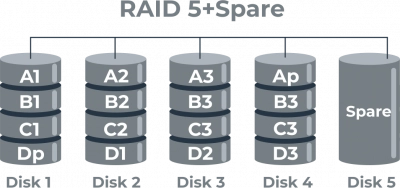Here is everything you need to know about RAID 5E/5EE
In this article you will find out:
- about RAID 5E/5EE
- how to protect your data
Are you ready? Let's read!
This article will discuss the non-standard and interconnected RAID levels - RAID 5E and RAID 5EE. You will learn not only about all the intricacies of these arrays, but also about the most effective methods for restoring these arrays in critical situations.
RAID 5E

RAID 5E (Enhanced), then RAID 5E is a RAID 5 array with a hot spare disk, which is actively used in array operations. In a traditional RAID 5E configuration, a hot spare sits next to the array, quietly waiting for a disk failure. The hot spare is then available and the array rebuilds the dataset with new hardware. Here are the benefits you can get:
- You can be sure that the disk that was used as a hot spare is in a healthy state.
- This array has an additional disk, which additionally distributes the I / O load to the array.
- The performance of RAID 5E is better than that of regular RAID 5.
Along with these features and benefits, you should accept the following drawbacks:
- The choice of controllers is small.
- The hot spare is not shared with arrays — this can affect overall storage costs if your system has multiple RAID 5 arrays.
- Recovery is slow.
With RAID 5E, you will "lose" the capacity of two drives — one for parity and one for hot spare. Therefore, a minimum of four drives must be used for RAID 5E.
RAID 5EE
RAID 5EE differs from RAID 5E in terms of capacity hot spare, which is integrated into a striped set. As a result, RAID 5EE rebuilds much faster than RAID 5E because in RAID 5E all empty space is located at the end of the array.
All other advantages and disadvantages of RAID 5EE do not differ from RAID 5E. The biggest negative point is the small choice of controllers that support a given RAID level. The minimum number of disks required is 4 to 8 or 16 disks in the array, depending on the controller. Tip: Minimum drives for RAID 5
Protect your high disk data!
DiskInternals RAID Recovery helps to rebuild an array and recover missing information. This application is the leading one for the current year, as it has been improved by leading IT specialists and has been kept up to date for the past 15 years. As mentioned above, the application has the popular free disk imaging feature and is good at restoring all common arrays. The application automatically detects the source RAID type and also provides full manual control. This is especially handy because you can track and control the recovery process. A free preview is a great bonus in addition to the main features of the app. Purchasing a license is not required here, but if you want to export the recovered data, then a license is required.
Recovery algorithm using this product:
- Install DiskInternals RAID Recovery on your computer.
- Open the application and launch the Recovery Wizard. Connect each RAID drive separately to your computer.
- The program automatically detects the available arrays - select the one you need.
- Next, select the recovery mode. After scanning, preview the results for free and then complete the whole process by exporting the data. Remember, you need a license for this.
- Follow these guidelines and you will succeed. Good luck!
